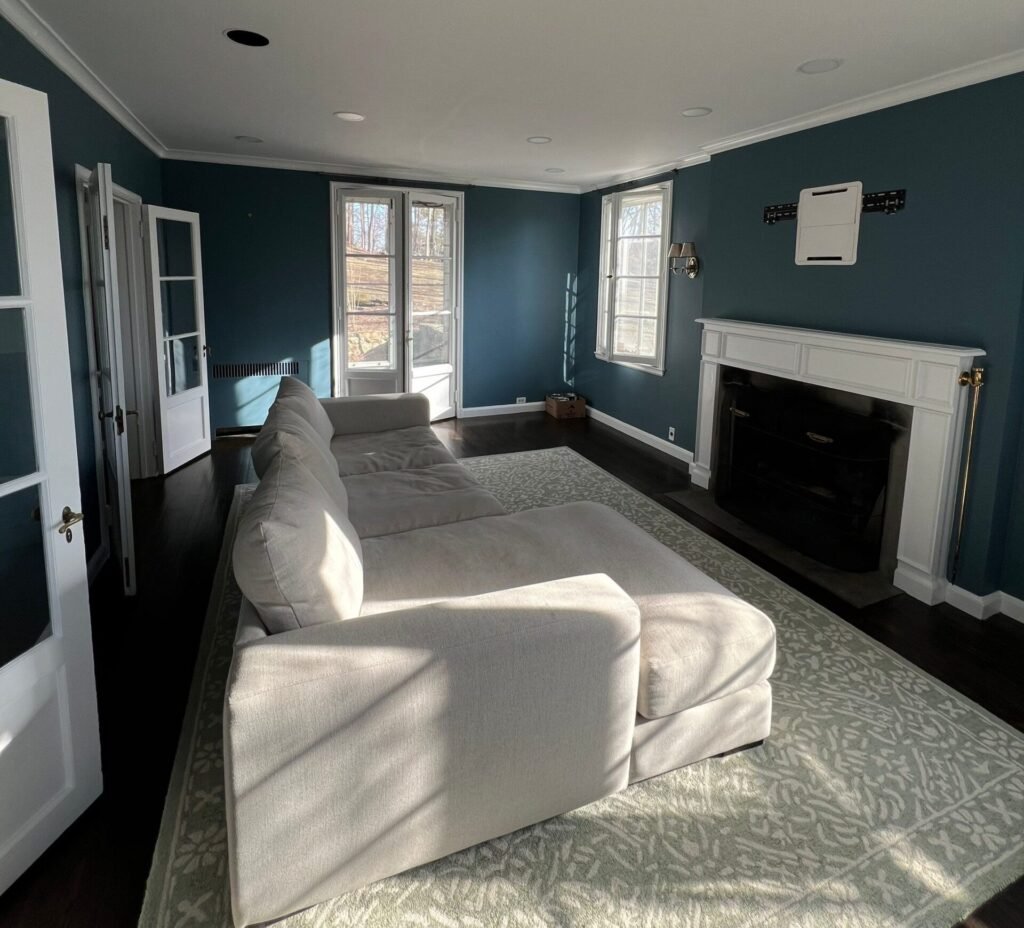Choosing the right type of paint is as important as selecting the perfect color for your home. While both oil-based and water-based paints serve the fundamental purpose of beautifying and protecting surfaces, they have distinct features that make them suitable for different applications. Understanding these differences, from drying time to durability and environmental impact, is key to a successful and long-lasting paint job. Genesis Pro Painting guides you through the pros and cons of each to help you make the best choice for your project.

What’s oil-based paint? Features & applications
Oil-based paints, also known as alkyd paints, use natural oils (like linseed oil) or synthetic alkyd resins as their binders and mineral spirits or paint thinner as their solvent. They dry through a process of oxidation and solvent evaporation, forming a very hard, durable film.
- Key Features:
- Durability: Dries to a very hard, protective finish that resists scuffs, scratches, and stains exceptionally well.
- Smooth Finish: Tends to level out smoothly, minimizing brush marks.
- Adhesion: Excellent adhesion to various surfaces, including previously painted oil-based surfaces, bare wood, and metal.
- Water Resistance: Forms a hard, non-breathable layer that offers superior moisture resistance once cured.
- Sheen: Historically offered higher gloss levels, though modern water-based paints have improved in this regard.
- Common Applications:
- High-Traffic Areas: Ideal for surfaces that endure a lot of wear and tear.
- Trim & Doors: Especially interior doors and trim that are frequently touched or bumped.
- Cabinets & Furniture: Creates a smooth, durable finish that can withstand frequent cleaning.
- Metal Surfaces: Provides excellent rust prevention and adhesion to wrought iron, railings, and metalwork.
- Floors: Historically used for porch and floor paint where extreme durability was needed.
What’s water-based paint? Advantages & uses
Water-based paints, commonly referred to as latex or acrylic paints, use water as their primary solvent. They dry as the water evaporates. Modern advancements have significantly improved their performance, making them the most popular choice for general painting.
- Key Advantages:
- Low VOCs & Odor: Significantly lower Volatile Organic Compound (VOC) content and less odor during application and drying, leading to better indoor air quality.
- Faster Drying Time: Dries much quicker than oil-based paints, allowing for multiple coats in a single day.
- Easy Cleanup: Tools, brushes, and spills can be cleaned up with just soap and water.
- Flexibility: Remains more flexible as it dries and cures, making it less prone to cracking, chipping, and yellowing over time, especially with temperature fluctuations.
- Color Retention: Excellent non-yellowing properties, especially in low-light conditions, and superior resistance to fading from UV exposure for exterior applications.
- Versatility: Can be used on a wide range of surfaces, including drywall, plaster, wood, and masonry.
- Common Uses:
- Interior Walls & Ceilings: The go-to choice for bedrooms, living rooms, hallways, and kitchens due to low odor and quick drying.
- Exterior Siding & Trim: Modern acrylic latex paints offer excellent weather resistance, UV stability, and flexibility for wood, vinyl, fiber cement, and stucco.
- Basements & High-Humidity Areas: Specific formulations offer mildew resistance and breathability for moisture-prone areas.
- Kid’s Rooms & Nurseries: Healthier choice due to low VOCs.
Side-by-side comparisons: Drying time, VOC, UV fade, durability, cleanup
Here’s a direct comparison of key attributes:
| Feature | Oil-Based Paint | Water-Based Paint (Latex/Acrylic) |
| Drying Time | Touch-dry: 6-8 hours. Recoat: 24 hours. Full Cure: Up to 7 days or more. | Touch-dry: 1-2 hours. Recoat: 2-4 hours. Full Cure: 30 days. |
| VOC Content | High (Strong odors, harmful fumes). | Low to Zero (Minimal odor, safer for indoor air quality). |
| UV Fade (Exterior) | Can chalk, crack, and yellow over time, especially lighter colors. | Excellent resistance to fading and yellowing; retains color well. |
| Durability | Dries to a very hard, smooth, scratch-resistant finish; good for high-impact areas. | Very durable with modern formulations; excellent flexibility, less prone to cracking. |
| Cleanup | Requires mineral spirits, paint thinner, or turpentine. | Easy cleanup with soap and water. |
| Adhesion | Excellent, especially on bare wood, metal, and previously oiled surfaces. | Good on most surfaces; may require specific primer over glossy oil-based paint. |
| Flexibility | Less flexible; can become brittle and crack with temperature changes. | More flexible; expands and contracts well with surfaces, reducing cracking. |
| Yellowing | Prone to yellowing over time, especially in low-light areas. | Resists yellowing; colors stay true. |
Export to Sheets
Best uses for each: Cabinets/Trim vs. Walls/Exteriors
While modern water-based paints have significantly closed the gap in performance, general guidelines still apply:
Choose oil-based paint for:
- High-Wear Interior Surfaces: Kitchen cabinets, interior doors, baseboards, and window trim, where a super-durable, smooth finish is desired to withstand frequent handling and cleaning.
- Metal Surfaces: Best for raw metal, wrought iron, and exterior railings due to superior adhesion and rust inhibition (though specialized DTM water-based primers can work too).
- Old, Previously Oil-Painted Surfaces: When repainting over existing oil-based paint, using another oil-based coat is the simplest and most direct approach, especially if the surface is in good condition.
Choose water-based paint for:
- Interior Walls & Ceilings: The overwhelming choice for bedrooms, living rooms, and general living spaces due to low odor, quick drying, and easy cleanup.
- Exterior Siding: Best for most siding materials (wood, vinyl, fiber cement, stucco) due to excellent flexibility, UV resistance, and breathability.
- Bathrooms & Kitchen Walls: Good for these areas due to moisture resistance (especially specific formulations) and ease of cleaning, provided they are not high-impact surfaces like cabinets.
- New Drywall & Plaster: Adheres excellently to these common interior substrates.
Prep & application tips for switchovers (Priming)
Switching between paint types requires careful preparation to avoid adhesion issues.
- Identify Existing Paint Type: If you’re painting over an existing finish and are unsure if it’s oil-based or water-based, perform a simple test:
- Dab a cotton ball or cloth with denatured alcohol.
- Rub it on an inconspicuous area of the painted surface.
- If paint comes off on the cloth, it’s likely water-based. If no paint comes off, it’s likely oil-based.
- Switching from Oil-Based to Water-Based: This is the most common scenario and requires proper priming.
- Clean & Degrease: Thoroughly clean the surface to remove all dirt, grease, and grime.
- Dull the Sheen: Lightly sand the entire surface with 180-220 grit sandpaper to dull any existing sheen and create a “tooth” for the primer to grip. Wipe off all sanding dust.
- Apply an Oil-Based Primer: This is the critical “bridge” step. Apply one coat of a high-quality, oil-based stain-blocking primer (e.g., Zinsser B-I-N Shellac-Based Primer or Kilz Original Oil-Based Primer). This primer will adhere well to the old oil paint and provide a stable surface for the new water-based topcoat.
- Paint with Water-Based Topcoat: Once the oil-based primer is completely dry according to manufacturer instructions, you can safely apply your water-based paint.
- Switching from Water-Based to Oil-Based: This switch is less common but generally simpler.
- Clean & Lightly Sand: Clean and lightly sand the surface to create adhesion.
- No Special Primer Needed: You typically don’t need a special primer. Oil-based paint adheres well to most properly prepared water-based surfaces.
Environmental impact & long-term care
Environmental impact:
- Water-Based Paint: Generally considered more environmentally friendly due to lower VOC emissions, which contribute less to air pollution and ozone depletion. Cleanup with water also avoids the need for harsh chemical solvents. Many manufacturers offer low- or zero-VOC options.
- Oil-Based Paint: Contains higher levels of VOCs, leading to stronger odors and off-gassing that can linger for days or weeks, impacting indoor air quality. Cleanup requires chemical solvents, which are hazardous and require proper disposal. Some regions and states have restrictions on the sale of high-VOC oil-based paints.
Long-term care:
- General: Regular cleaning with mild soap and water, prompt stain removal, and addressing any moisture issues are key for both types of paint.
- Oil-Based: Their hard finish can be scrubbed vigorously for cleaning. However, if they crack due to lack of flexibility, repairs can be more noticeable. May yellow over time, especially in areas not exposed to UV light.
- Water-Based: Maintain color better, are flexible, and resist cracking. Modern formulations are very washable. Small imperfections are easier to touch up without noticeable flashing.
By understanding these distinctions, U.S. homeowners can confidently select the paint that best suits their project’s needs, ensuring a beautiful and durable finish for years to come.
Confused about which paint is right for your project? Don’t guess! Genesis Pro Painting helps homeowners choose the perfect paint type and applies it with professional precision for results that last. Contact us today for expert advice and a free estimate!






